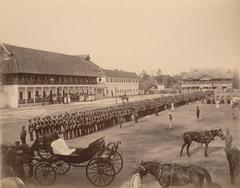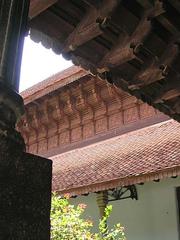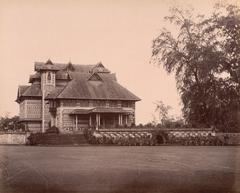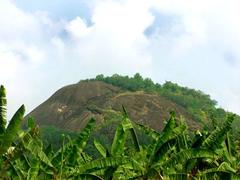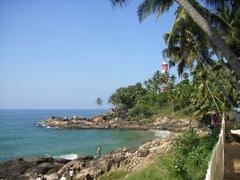Raj Bhavan Thiruvananthapuram: Visiting Hours, Tickets & Complete Visitor Guide
Date: 04/07/2025
Introduction
Raj Bhavan Thiruvananthapuram, the official residence of the Governor of Kerala, stands as an enduring symbol of the state’s political history, colonial legacy, and cultural vibrancy. Set atop a lush 12-hectare estate in the heart of Kerala’s capital, it is both a seat of constitutional authority and a showcase of architectural grandeur blending colonial and traditional Kerala styles. While Raj Bhavan is primarily a working gubernatorial residence, its historical significance, artistic features, and botanical initiatives have made it a sought-after destination for history enthusiasts, architecture buffs, and cultural travelers.
This guide provides a detailed overview of Raj Bhavan’s origins, architectural evolution, political and cultural importance, and practical visitor information—including visiting hours, ticketing, accessibility, and tips for making the most of your visit. Whether you are seeking to explore Kerala’s colonial-era landmarks, engage with its living heritage, or plan an educational trip, this article offers comprehensive insights and the latest protocols for an informed and rewarding experience (Kerala Raj Bhavan official website, Mapcarta).
1. Historical Overview
Origins and Early History
Raj Bhavan’s origins trace back to the era of the Travancore princely state. Initially a royal property, the site gained prominence when the capital shifted to Thiruvananthapuram in the late 18th century under Maharaja Dharma Raja Karthika Thirunal Rama Varma. During the British colonial period, a Resident’s House was established here, serving as the official residence of the British Resident—an intermediary between the Crown and the Travancore monarchy. The present structure, built in the early 19th century, embodies architectural elements from both British and Kerala traditions (Kerala Raj Bhavan official website).
Architectural Evolution
The estate’s main building, completed in 1829, reflects a blend of colonial and native Kerala styles. Notable features include high ceilings, spacious halls, wide verandahs, and sloping tiled roofs—design choices well-suited for Kerala’s tropical climate. Over time, the estate expanded to include staff quarters, recreational facilities, and gardens. The interiors are adorned with antique furniture, wooden paneling, and art that narrate Kerala’s sociopolitical heritage (Wikipedia).
2. Political and Cultural Significance
Political Role
Following the integration of Travancore into the Indian Union and Kerala’s formation in 1956, Raj Bhavan became the official Governor’s residence. The Governor, as the constitutional head, hosts state ceremonies, swearing-in functions, and high-level meetings here. The Durbar Hall is a key venue for official events and diplomatic receptions. Raj Bhavan’s role as a venue for political negotiation and constitutional deliberation underscores its ongoing importance in Kerala’s governance (SPMRF).
Cultural and Symbolic Importance
Beyond administration, Raj Bhavan is a prominent cultural landmark. It has hosted art exhibitions, literary gatherings, and national celebrations. Its gardens and lawns are settings for flower shows and environmental programs. In recent years, the estate has also become a focal point for debates on constitutional values and cultural symbolism—such as the 2025 controversy over the display of a Bharat Mata image during public events (Onmanorama, The Hindu).
3. Environmental Features and Digital Initiatives
Raj Bhavan Gardens
The 3.24-hectare gardens are celebrated for their botanical diversity and landscape design. Highlights include:
- Extensive orchid and rose collections
- Bamboo garden and rare begonia beds
- Artificial waterfall and three greenhouses
- Sculptures from Mayiladi, Tamil Nadu
Digital Garden
Raj Bhavan is the first gubernatorial residence in India to launch a Digital Garden. Developed with the University of Kerala, this initiative allows visitors to scan QR codes on trees and plants for detailed species information, enhancing educational value (Times of India).
Environmental Stewardship
The estate is a haven for local flora and fauna and hosts regular environmental awareness events, including World Environment Day. Sustainable gardening practices—such as organic fertilizers and water conservation—are actively followed (The Hindu).
4. Visitor Information
Location and Access
- Address: Near Vellayambalam Junction, Kowdiar Road, Thiruvananthapuram
- Distance: ~4 km from city center, 6 km from railway station, 10 km from airport
- Transport: Accessible by taxi, auto-rickshaw, or public bus (Raj Bhavan official site)
Visiting Hours
- General Public: Access is limited, usually allowed only during special events, public holidays, or by prior appointment.
- Typical Timings: 10:00 AM – 4:00 PM (when open); some guided tours may start at 9:00 AM (Curly Tales)
Tickets and Entry
- Entry Fee: Generally free; a nominal fee may apply for official guided tours.
- Permission: Prior registration or official approval required for all visits.
- Booking: No online ticketing as of mid-2025; contact the Raj Bhavan Public Relations Office in advance (Kerala Raj Bhavan official website).
Security and Visitor Regulations
- Security: ID verification and screening mandatory; estate guarded by security personnel.
- Photography: Permitted in gardens and designated spots. Restricted inside buildings and during official events.
- Prohibited Items: Large bags, sharp objects, unauthorized electronics.
- Dress Code: Modest, respectful attire required.
Accessibility
- Wheelchair access is available in selected areas; the hilltop terrain may challenge those with mobility issues. Prior notification is advised for special needs.
Facilities
- Restrooms: Available during events or tours.
- Onsite Amenities: No public cafeteria; plan refreshments accordingly.
- Library: Private collection of 6,000 books (not open to general public).
- Children’s Park and Sports Courts: Primarily for residents and official guests.
5. Guided Tours and Visitor Experience
- Guided Tours: Offered occasionally during flower shows, cultural festivals, and environmental events. Tours cover history, architecture, gardens, and digital initiatives.
- Duration: Allocate 1.5–2 hours for a comprehensive visit.
- Best Time to Visit: During special events or flower shows for maximum access and experience.
6. Nearby Attractions and Suggested Itinerary
Raj Bhavan’s central location makes it an excellent starting point for exploring Thiruvananthapuram’s heritage:
- Kowdiar Palace: 15-minute walk; former royal residence (Trek Zone)
- Napier Museum: 19-minute walk; Indo-Saracenic architecture and rare artifacts
- Thiruvananthapuram Zoo: 17-minute walk; one of India’s oldest zoos
- Kanakakkunnu Palace: 13-minute walk; cultural festivals and events
Suggested Itinerary: Combine a visit to Raj Bhavan with these sites for a full day of cultural exploration.
7. Frequently Asked Questions (FAQs)
Q1: Are there entry fees or tickets required to visit Raj Bhavan?
A1: No public ticket sales; entry is free but by prior permission only.
Q2: When can I visit Raj Bhavan Thiruvananthapuram?
A2: During special events, public holidays, or by prior arrangement. Check the official website for updates.
Q3: Is photography allowed?
A3: Permitted in gardens; restricted indoors and during official events.
Q4: How do I book a guided tour?
A4: Contact the Public Relations Office ahead of time. No online booking system currently exists.
Q5: Is Raj Bhavan accessible for visitors with disabilities?
A5: Some areas are accessible; inquire about specific needs in advance.
8. Visuals and Interactive Resources
- High-resolution images of Raj Bhavan’s main entrance, gardens, and interiors are available online.
- Interactive maps and occasional virtual tours are provided during special events; check official resources for updates (Kerala Raj Bhavan official website).
9. Travel Tips
- Arrange your visit well in advance and confirm permissions.
- Wear comfortable shoes for exploring the gardens.
- Carry water and sun protection, especially during warm months.
- Use local transport for convenience, as parking may be limited during events.
10. Summary and Final Recommendations
Raj Bhavan Thiruvananthapuram is a unique site where Kerala’s political history, cultural traditions, and architectural beauty converge. Its meticulously preserved gardens, heritage buildings, and innovative Digital Garden initiative make it a rewarding destination for those interested in the state’s legacy. Although access is regulated, planning ahead and aligning your visit with public events or guided tours can provide a rare and enriching experience. Combine your trip with visits to adjacent heritage sites for a comprehensive cultural itinerary.
Stay updated on visiting hours and permissions through the official Kerala Raj Bhavan website and supplement your planning with digital tools like the Audiala app for real-time travel tips. For more about Kerala’s rich cultural and historical landscape, explore our related guides and follow us on social media for upcoming events and travel inspiration.
Sources and Further Reading
- Kerala Raj Bhavan official website
- Mapcarta
- Curly Tales
- Onmanorama
- Wikipedia
- Times of India
- The Hindu
- Trek Zone
- SPMRF
